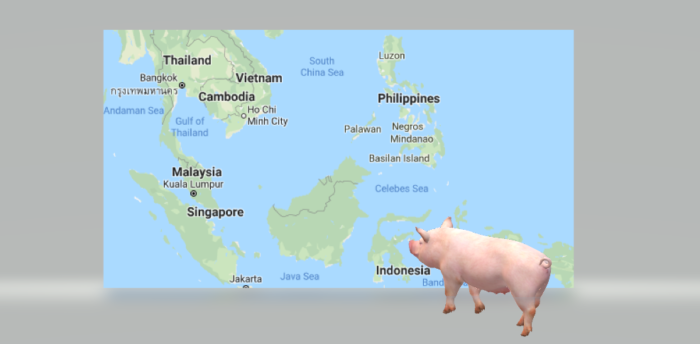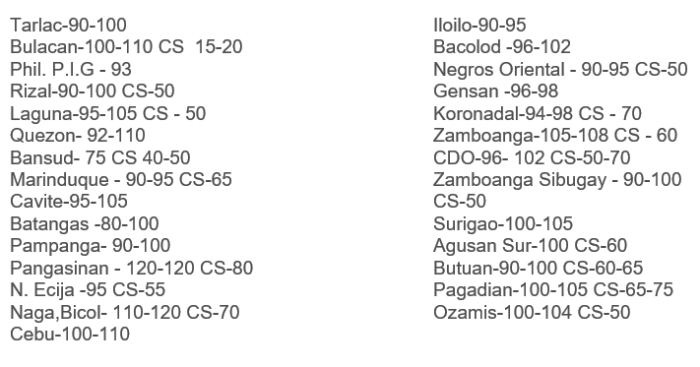
Philippines

As of the 1st October 2019, the total swine inventory in the Philippines was estimated at 13.01 million heads according to the Philippines Statistics Authority. This represents a decrease of nearly 1% compared to the previous year. The local hog industry has lost a total of PHP 4 billion (~80 million USD) since mid-August, due to ASF.
As we have seen in other regions hit by ASF, the hog prices decline due to the false concerns of the consumers. It is estimated that demand for pork at wet markets went down by 50%, while demand at the supermarkets went down by 20%. Compared to pre-ASF the net liveweight price dropped by up to 25% causing most of the industry to be below the cost of production estimated
Among the regions, Central Luzon recorded the highest swine inventory of 2.21 million heads, followed by Calabarzon at 1.57 million heads. The combined stocks of these 2 regions accounted for 29 % (3.78 million heads) of the country’s total swine inventory.
Since then, the two regions of Central Luzon and Calabarzon were hit by ASF. It
is suggested that 30-40% of the swine population in these two regions broke
with ASF. Most of the backyard farms in this area have already closed their
operations.
The backyard population is estimated to be 8.2 million, a decrease of 1.7% compared to the previous year. The reduction in backyard farms and the restocking of the herds culled for ASF should in the medium to long term have a positive effect on the overall health in the swine industry.
Outbreaks have decreased, increasing the confidence of the public and bringing back business. DA still urges compliance with zoning and control efforts. Under the zoning plan, areas in the country will be classified by their ASF status — free zones, containment zones, surveillance zones, protected zones, and infected zones.
- Visayas, Mindanao, and Mimaropa regions are considered free zones. This means that these areas can freely trade their products anywhere in the country.
- For the containment zones, regions 1 (Ilocos), 2 (Cagayan Valley), and 5 (Bicol) are protected zones;
- Regions 3 (Central Luzon) and 4A (Calabarzon) are surveillance zones;
- Bulacan and Pampanga are infected zones.
Some of the larger productions have started to increase their breeding stock numbers and this is expected to continue to take up the slack of the backyard farms and in anticipation of the potential record-high hog prices to follow. We expect the demand for pork to resume in the spring of 2020 and the hog prices to raise from then in line with supply and demand.
In the last quarter of 2019, Genesus Inc. has stocked a new high health 2,500 Sow Nucleus/ Multiplier for Genesus Philippines owned by Golden Harvesta. They will produce purebred Yorkshire, Landrace, Duroc, and F1 parent breeding stock for sale later in 2020.
Vietnam
The liveweight pig price in Vietnam is now 78,000 – 88,000vnd/kg in the North; 80,000 – 85,000 vnd/kg in the centre and 77,000 – 84,000 vnd/kg in the South. The average will be around 81,000vnd/kg. (3.5 USD/kg)
Price has reduced due to pigs from Thailand coming into the Vietnam market. Information from Vietnam Government reports Vietnam to be importing high quantities of meat, especially pork in an effort to keep the meat price down.
Pork shortage has been gripping the country following months of excess pork supply due to panic slaughtering of the herd, which has the effect of depressing prices. It is believed that the existing pork supply shortage is likely to persist over 2020. This would also put upside pressure on the prices of other animal protein. Pork production is likely to only recover somewhat closer to 2023.
Food inflation almost doubled to 9.2% in December 2019, from 5.6% in November 2019, on the back of rocketing pork prices due to the outbreak of African Swine Fever, which has affected all 63 provinces. High inflation also weighs on Vietnam’s export competitiveness.
Prior to ASF, Dong Nai province had an estimated 2.5 million pigs. After the effects of the ASF outbreak, Dong Nai culled 1.4 million heads. Now, Dong Nai province has plans to restock. Large pig producers are planning to expand breeding sow herds.
Hung Vuong JSC (HVG) & THADI (owned by the Thaco Group) signed a contract of a strategic cooperation agreement. Under a newly-signed agreement, Thadi will hold a 65 % stake in a joint venture with HVG to raise up to 1.2 million pigs annually.
Minister of Agriculture and Rural Development Nguyen Xuan Cuong highly spoke of the cooperation, saying the strategic deal will contribute to developing hi-tech farming in Vietnam.
Thailand
Live pig price in Thailand has reached its peak at 2.6 USD/kg in January 2020. However, the price tends to move downward as the government takes action to curb live pig exports.
Growing demand for live pigs in Cambodia and Vietnam is motivating for Thai pig farmers to boost their exports across the border. As the Lunar New Year is looming, live pig prices in Vietnam hovered to 3.5 USD/kg and 2.8 USD/kg in Cambodia.
The Thai Swine Raisers Association estimated that the pig population in Thailand was at about 950,000 heads in 2019, 15% lower than the previous year. The farmers reduced the number of breeding stock throughout last year due to concerns over African Swine Fever, which is hitting neighboring Laos, Cambodia and Myanmar. Thailand is expected to produce 22 million market pigs this year
The association said pig supplies in Thailand would continue to be tight over the next few months as the summer is coming. Rising temperature leads to the slow growth of pigs and a shortage of water will raise the production cost further.
Indonesia
The Indonesian Ministry of Agriculture has confirmed the presence of African Swine Fever (ASF) in 19 areas in Northern Sumatra. Information from the OIE indicates that there are a total of 392 outbreaks with 1.2 million susceptible animals. The disease poses a threat to the Indonesian pig population comprising approximately 8.5 million animals.
The main strategic measures to prevent ASF infection are:
- implementing biosecurity systems and good farm management;
- strict and intensive supervision of high-risk areas;
- a stricter policy on importing live pigs and pork products.
The government is calling on other provinces with high pig populations to be vigilant for the possible spread of ASF.
Categorised in: Featured News, Global Markets
This post was written by Genesus



